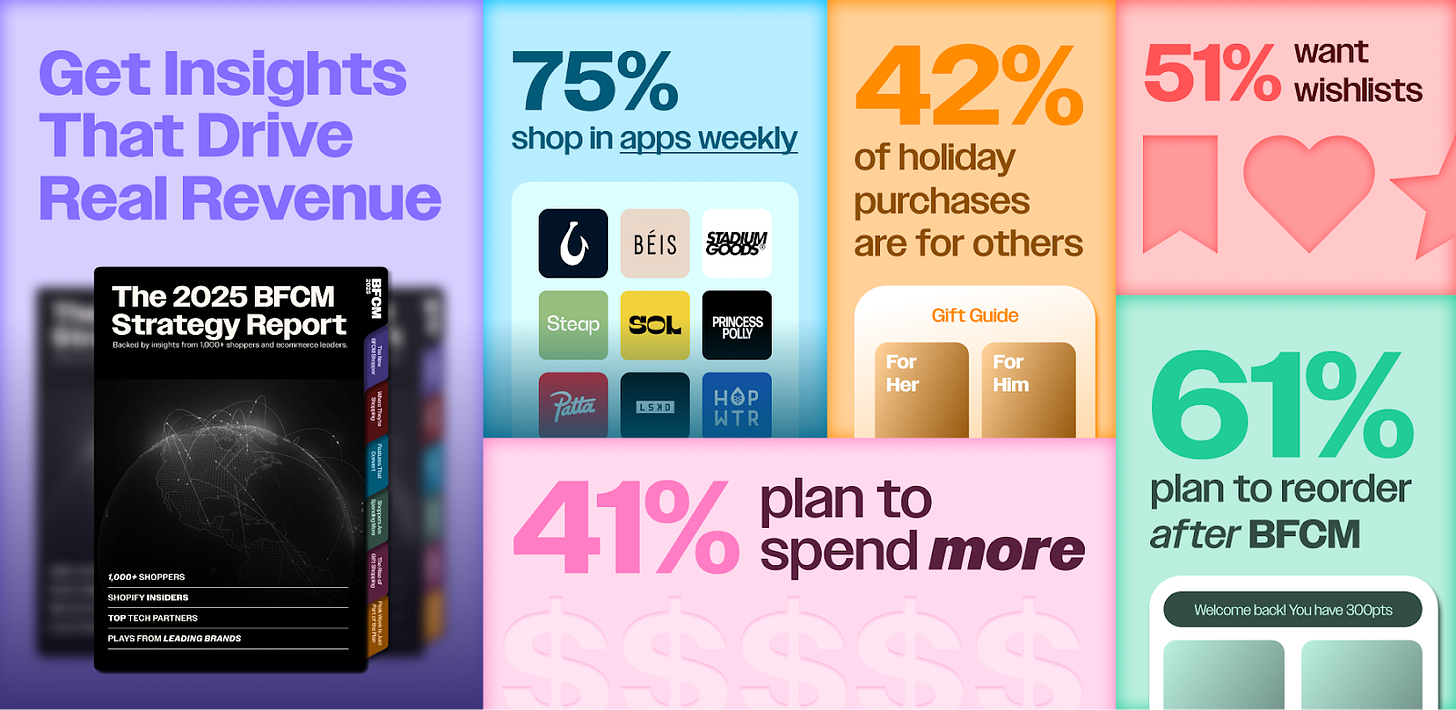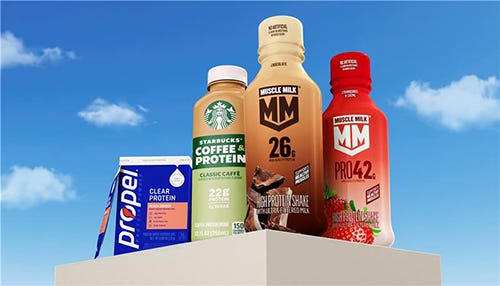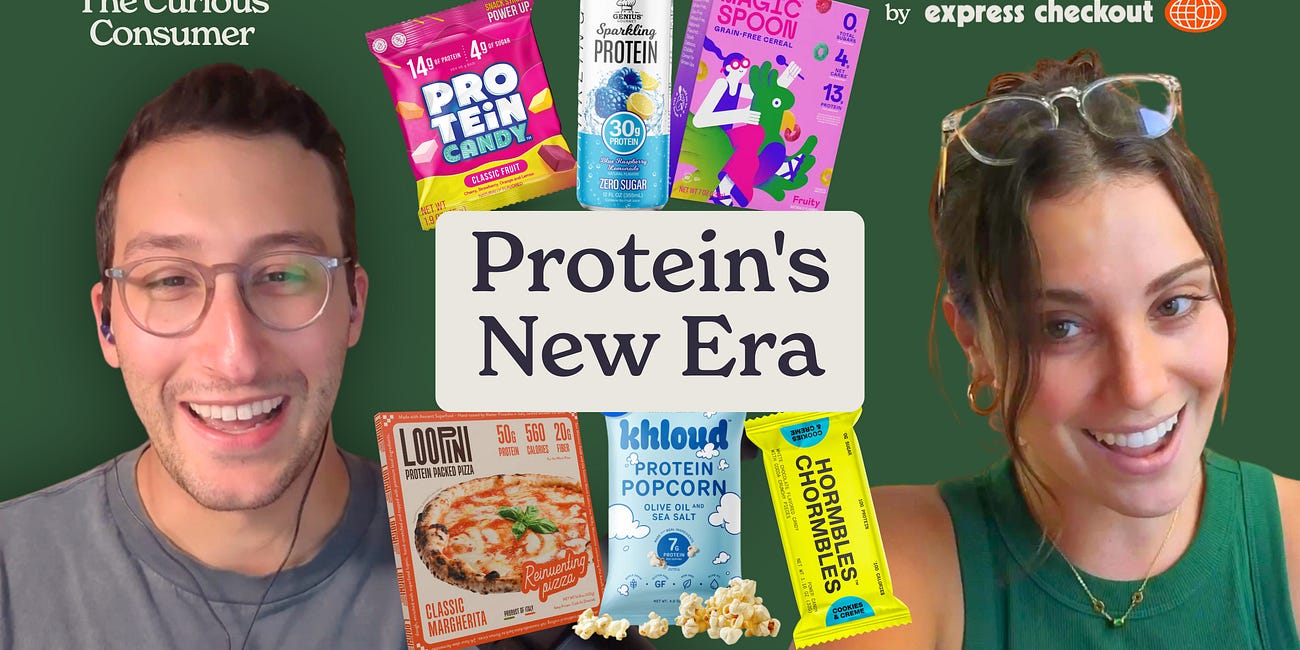THC bevs are now at Target
CPG and retail news from the week of 10/6/25
Hello hello!
A little confession: We write about BFCM strategies every year… but we’ve never actually run one. 🫣
What we are, though, is professional BFCM shoppers. Which means we know what works on us—and what makes us immediately delete an email. This week, we found a tactic that explains why some brands get our money and others don’t:
As Tapcart’s 2025 BFCM Playbook explained: Stop treating all your customers the same.
That “BIGGEST SALE EVER! 25% OFF EVERYTHING!” email you’re sending to literally everyone—whether they dropped $1,000 last year or signed up for 10% off and ghosted? It doesn’t work. Not on us, not on anyone.
What does work? Segmenting by Recency, Frequency, and Monetary Value (RFM):
Your champs/VIPs: Give them early access and exclusive bundles—they don’t need discounts, they want to feel special (don’t we all? 🥹)
Potential loyalists: Hit them with time-limited offers to encourage a second purchase. “Complete your collection before midnight” works on us every single time…
Deal hunters: Sure, give them discounts, but bundle with higher-margin items to protect profit. Make them add two items to get 30% off—they’ll do the math and convince themselves it’s worth it.
The playbook is packed with tactical tips that turn insights into revenue—from building a “loyalty flywheel” to factoring LLMs into your strategy and SO much more.
Now, let’s get into the news of the week →
News from the week
Target just became the first mainstream retailer to sell THC beverages. This changes everything.
First, let’s clarify: the retail giant is soft-launching THC-infused beverages at select stores in Minnesota, starting with 10 locations and featuring a dozen brands including Birdie, Cann, Gigli, Hi Seltzer, Indeed Brewing Company, Señorita, Stigma, Surly Brewing Co., Trail Magic, Wunder, Wyld, and Wynk.
Though this is starting as a small-scale test, it’s still a BIG deal. This is the market indicator the cannabis industry has been building towards since the 2018 Farm Bill created the legal foundation for hemp-derived THC products. What we’re witnessing is nothing less than the birth of alcohol’s first real competitor in centuries.
The numbers tell the story: The global cannabis beverage market hit $1.16 billion in 2023 and is projected to reach $117 billion by 2032—potentially exceeding today’s entire energy drink market.
At Total Wine locations, THC beverages already command 20+ feet of shelf space and represent up to 14% of revenue in some stores. That’s not replacing alcohol—it’s purely additive.
And the money is flowing…
Uncle Arnie’s just raised $7.5M to scale nationally
Nowadays raised $10M and partnered with Kygo’s Palm Tree Crew festivals
BRĒZ just opened a $25M raise just as it has surpassed $60 million in profitable revenue
The transformation is happening at three levels:
Retail legitimization: When Target carries something, suburban America notices. This isn’t a sketchy corner store or even a progressive liquor retailer—this is where America shops for diapers and groceries. As WYNK’s co-founder Angus Rittenburg told us: “We had a heck of a challenge in 2021 persuading non-cannabis consumers to go into a dispensary. Now the world is completely different—we’ve finally been able to place this product where the alcohol consumer shops. The growth is absolutely insane.”
The shopping experience itself, at both newer dispensaries and regular retail, marks a significant departure from traditional cannabis retail. Consumers can browse products freely, read labels, and compare options—a stark contrast to the behind-the-counter ordering systems (and overall intimidating vibes) common in dispensaries. This comfy retail environment—our trusty friend Tarjay—removes friction and hesitation for first-time or occasional consumers.
The microdosing revolution: These aren’t your older sibling’s 1000mg THC edibles. Most beverages contain just 2-5mg of THC—enough for a gentle buzz without the anxiety of overconsumption. It’s the “Goldilocks zone” that makes THC approachable for a much broader audience. People can now choose their experience with granularity, building up from small doses until they find their personal sweet spot. This controlled approach removes much of the anxiety and unpredictability historically associated with cannabis.
Demographics destroying stereotypes: The biggest surprise? Who’s buying. WYNK discovered their core audience isn’t 25-35 year olds—it’s 45-65 year olds looking to cut back on alcohol. Rittenburg told us: “People approaching retirement tell us, ‘We have two cans of Wynk every night. It cuts our alcohol consumption dramatically, and we’ve never slept better.’”
When suburban women in their 40s and 50s choose THC seltzers over white wine at social gatherings, it signals a profound cultural shift. For many of these consumers, THC beverages represent their first-ever cannabis experience, unlocked by familiar formats and trusted retail environments.
What happens next: If Target’s Minnesota pilot succeeds, expect rapid expansion. The company operates 1,900+ stores nationwide, and success here could (legislation permitting) trigger a domino effect. The brands that win won’t just have great products—they’ll need infrastructure to scale overnight.
As Rick Schepp, GM of Beverage at Green Thumb Industries (GTI), the parent company of Señorita, told us:
“This year, we have already seen massive growth in various channels including on-premise, brick & mortar, and DTC, and this is just the beginning. We are setting Señorita up to be where the consumer is by expanding our distribution channels to reach more consumers. We’re confident that strong shopper response and sales performance will continue to validate the value of broader retail expansion, and we’ll be ready when our partners are.”
TL;DR: As stigma begins to fade and accessibility improves, THC beverages will become as commonplace as grabbing a beer.
The distinction between THC beverages and other functional beverages will likely blur, with cannabis becoming just one of many active ingredients chosen for specific effects. This shift would represent one of the most significant changes in American consumption habits in decades.
CPG & Consumer Goods
Whole Foods Market released their 2026 food trends, spotlighting beef tallow’s resurgence (shoutout Jesse & Ben’s for their well-timed nationwide Whole Foods launch), fiber-forward innovations, female farmers leading the charge, “kitchen couture” (AKA shmancy packaging), elevated frozen meals, versatile vinegars, mindfully sweetened indulgences (think: honey-, fruit-, or date-sweetened), and reimagined instant foods.
We know that some of our readers may be thinking: these trends aren’t new—we’ve been seeing them. But in our little industry bubble, trends look a lot different than they do to the average consumer. There’s latent impact—and soon, the trends we’ve all been noodling on will mosey their way onto shelves in a more visible way.
Last year, Whole Foods predicted a few trends that definitely came to fruition, like hydration, international snacking, and protein (and you know how we feel about protein 👀). But it also predicted some that didn’t quite make it to the masses, like plant-based aquatic ingredients and fully-compostable packaging. Like any trend report: take it with a grain of salt. Know that these are areas that Whole Foods—a premium natural grocer—is seeking out, but they are also likely not representative of the “average” American’s shopping cart.
What do we think? How kind of you to ask :’) We’re equally bullish on elevated frozen and instant categories, feel solidly confident on fiber, “mindful” sweeteners, and “kitchen couture” (the people loooove performative panty items), and are cautiously optimistic about the average consumer caring enough to read about a product’s female farmers (though how cool would it be if they did?). Beef tallow—in anything other than fries—feels fleeting, and vinegar makes us feel…. honestly little to nothing, though we welcome being proven wrong. 🤷♀️
Shockingly, no squeezey bottles. Smash Kitchen, Glenn Powell’s condiment brand, is launching organic olive, avocado, and coconut oils exclusively at Walmart.
This is such an interesting brand. It perfectly exemplifies the “masstige” strategy Walmart’s been pursuing lately: premium quality at mass-market prices. The brand looks like a quality private-label brand, and, being that it is only available at Walmart…it essentially is. At the same time, all of the brand’s products are priced at or below standard brands (even some of Walmart’s more premium store brands), while emphasizing quality.
Powell’s hands-on involvement also sets this apart from typical celebrity ventures—he was literally cooking at Walmart’s Pregame activation this week.
Seriously though, I’m surprised there wasn’t a squeeze bottle in this line up. Almost every other oil brand and their mother has launched a squeezy version. It’s not good or bad, just interesting! - Nate
Meet the protein trifecta. PepsiCo is launching three protein-focused drinks: a ready-to-drink Starbucks coffee protein drink (22g protein), reformulated Muscle Milk shakes (26-42g protein), and Propel Clear Protein (20g protein in a single-serve powder format).
It’s not at all surprising that a BigCo brand like PepsiCo is riding the protein wave. But what’s interesting about this specific lineup is that it seems to be a last-ditch effort to bring some of PepsiCo’s less sexy brands back into the spotlight. Though I personally am a Propel fanatic (I buy it nearly every time I enter a Wawa) ((I am also a Wawa fanatic)), the brand has lost a lot of its “cool” factor as new hydration brands entered the scene. Muscle Milk, too, seems to have been overshadowed by brands like Fair Life. I’m curious if the protein upgrade will be enough to resurrect these sleepy giants… or if protein as a callout will become so baseline, consumers will soon glaze over these claims. - Jenna
Speaking of protein… Legendary Foods is launching an instant Protein Mac & Cheese with 47g of protein per serving. THAT IS A LOT. It also marks the brand’s entry into meals, after building its platform on snacks like protein pastries, sweet rolls, and chips.
…and STILL speaking of protein… we posted part 2 of our podcast on protein :) It features some of the coolest brands across all aisles, anonymous hot takes on protein (including one love so much, we may just get it on t-shirts), and some takeaways from our convo with Peter Rahal, founder of David Protein.
Everyone’s gotta smell good! Harry’s, the men’s grooming brand, launched its first cologne collection, featuring three unique scents at just $35. This move expands Harry’s offerings, appealing to cost-conscious consumers seeking quality.
Fragrance is definitely hot right now! The category has decisively led other beauty categories in growth during the first half of 2025, with prestige fragrance sales up 6% and mass market fragrance sales up 17%.
Gen Z consumers are driving this boom, spending $204.15 a year on cologne and perfume—$38 more than the average consumer. Unlike previous generations who wore “signature scents,” Gen Z chooses fragrances based on mood and vibes, leading to demand for smaller, affordable options that can be mixed and matched.
Brands to watch:
Snif has scaled from online and TikTok to brick-and-mortar presence at retailers like Ulta.
Dossier has seen significant growth, even opening a popup in NYC. The brand capitalizes on dupe culture with affordable alternatives to luxury scents.
Phlur was acquired by TSG Consumer, signaling investor confidence in the category.
Lore fragrance just launched, founded by Melanie Bender (Rhode’s former CEO), Joe Cloyes and Greg Gonzalez (co-founders of Youth to the People), and Mazdack Rassi (Milk Makeup founder), proving fragrance is the next wave with serious industry talent betting big on the category.
The Magnolia empire has entered the frozen aisle. Magnolia, the home brand founded by Chip and Joanna Gaines, launched Magnolia Table, a line of frozen baked goods (@Whole Foods trends: premium frozen, anyone?). Launching exclusively at Target, it features six signature recipes including buttermilk biscuits, cinnamon rolls, and chocolate chip cookies. YUMMY.
We spoke with Genevieve Gilbreath, Co-Founder and General Partner at Springdale Ventures (the first investors in Magnolia Table!), about the launch:
“Historically, there haven’t been a ton of transactions in frozen compared to shelf stable, or even refrigerated. But consumer behaviors have really changed—people are looking for fresh, delicious convenience, and it’s hard to get that shelf stable for meals or baking mixes,” Gilbreath said. Consumer behavior has really shifted more towards seeking frozen for meals or novelty desserts.”
eCommerce
Instacart 🤝 TikTok. Instacart is integrating its retail media data into TikTok Ads Manager, allowing advertisers to target consumers with high purchase intent—making it the first retail media network to offer this end-to-end solution.
Instacart has been making some serious moves in social media lately. Earlier this year, the retailer announced its partnership with Pinterest to make its ads shoppable, and now, it’s hitting up good ol’ TikTok to take that bet on social commerce even further.
Think of it this way: TikTok is where trends are born (remember the baked feta pasta? The cucumber salad craze?), and Instacart is where those trends turn into actual purchases. Now, brands can connect those dots in real-time.
Retail
Body is back. The Body Shop is coming back to the US…. but online to start. After being acquired out of U.K. administration in 2024, the beauty brand returns exclusively through eCommerce via its website and Amazon.
Funding news
Scooping up fresh funding. Alec’s ice cream, the regenerative ice cream brand, raised $11 million in Series A funding led by Imaginary Ventures. Their Culture Cups, individual ice cream cups they launched in 2025, have been instrumental in driving the company’s explosive growth, with orders tripling year-over-year and expanding Alec’s reach across new demographics and retail channels.
Alec’s is not only absolutely delicious—it’s also tapping into several key trends in food and beverage right now: A2 dairy, regenerative agriculture, and probiotic gut health.
For those who don’t know: A2 dairy contains only the A2 beta-casein protein, which some people find easier to digest than conventional milk that contains both A1 and A2 proteins. It’s positioned as a gentler alternative for those who experience discomfort from regular dairy, but aren’t lactose intolerant (which, after our societal oat milk craze, describes most of us these days…).
Society Brands acquired Crunchi, a DTC clean beauty and skincare brand expanding its portfolio to 13 brands with $160M+ annual sales. Society Brands’ focus on acquiring $10M-$40M revenue brands like PrimalLife (oral care), Vitality now (supplements), and Cleanomic (household).
Check out our fourth podcast episode (how?!) on protein below! We’re starting to build our guest list for podcast interviewees—so if there’s someone in consumer or retail that you’re dying to learn from/about, shoot us an email!
If you haven’t yet, please subscribe, like, and leave a comment! It helps us continue to bring you the most interesting news + nuance in consumer and retail every week.










